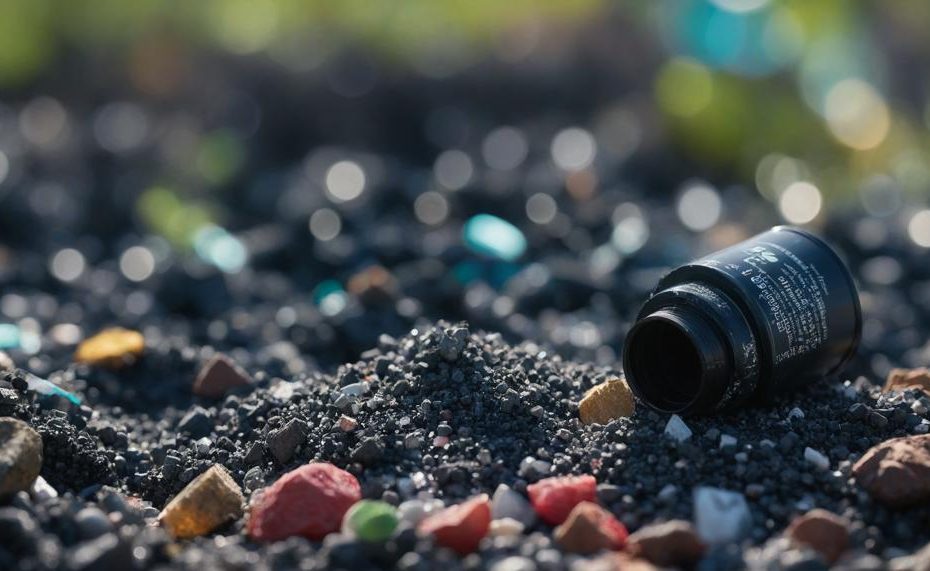How should carbon tetrachloride be disposed of? The answer is straightforward: contact your city’s hazardous waste disposal facility to ensure proper disposal. Carbon tetrachloride is a highly toxic chemical that poses significant health and environmental risks, making safe disposal critical.
Properly disposing of carbon tetrachloride is essential to prevent harmful effects on both the environment and public health. This substance, once commonly used in industrial applications, is now recognized for its dangerous properties and is being phased out. Improper disposal, such as throwing it in the trash or pouring it down the drain, can lead to severe contamination and legal repercussions.
Here are the key takeaways for safely disposing of carbon tetrachloride:
- Contact Your City’s Hazardous Waste Disposal Facility: They have the expertise and resources to handle and dispose of toxic chemicals safely.
- Follow Legal Regulations: Ensure you are aware of and comply with local laws regarding hazardous waste disposal to avoid penalties.
- Use Safety Gear: Always wear appropriate safety gear when handling carbon tetrachloride to protect yourself from exposure.
- Keep it in Its Original Container: Transport the chemical in its original container to avoid spills and ensure proper labeling.
- Transport Safely: Use thick wooden planks or other secure methods to transport the chemical to the disposal facility without accidents.
By adhering to these guidelines, you can responsibly dispose of carbon tetrachloride and contribute to a safer environment.
Contents
About Carbon Tetrachloride

Fire Extinguisher Types
Answer:
Fire extinguishers come in various types, each designed for specific classes of fire. Here’s a rundown of the different types and their primary uses:
| Type | Description | Primary Use |
| Water (APW) | Uses water to cool the flames. Not suitable for electrical fires or flammable liquids. | Class A fires (ordinary combustibles like wood, paper, and cloth). |
| Carbon Dioxide (CO2) | Displaces oxygen and uses a cold discharge to remove heat. Leaves no residue. | Class B (flammable liquids) and Class C (electrical) fires. |
| Dry Chemical (ABC, BC) | Multipurpose extinguishers using chemicals to interrupt the chemical reaction of a fire. | Class A, B, and C fires for ABC; Class B and C for BC. |
| Foam | Forms a barrier between the fuel and the fire, cutting off the oxygen supply. | Class A and B fires. |
| Wet Chemical | Specifically designed to tackle kitchen fires, it cools and forms a soap-like substance to prevent re-ignition. | Class K (cooking oils and fats). |
Regarding the disposal of carbon tetrachloride, it is a highly toxic chemical that must be handled with care. Using a fire extinguisher for its disposal is not appropriate. Instead, follow these steps:
- Containment: Keep carbon tetrachloride in its original container, clearly labeled.
- Protection: Wear appropriate safety gear, including gloves and goggles.
- Transportation: Transport it safely, possibly using thick wooden planks for support.
- Disposal Facility: Contact your local hazardous waste disposal facility for proper disposal instructions.
How to Dispose of Carbon Tetrachloride
The safest and most effective methods for disposing of carbon tetrachloride involve strict adherence to established protocols, professional handling, and environmental safeguards.
Given its hazardous nature and potential carcinogenic effects, it is critical to follow these guidelines to minimize risk to human health and the environment.
Proper Handling and Disposal by Trained Professionals
Disposing of carbon tetrachloride should always be managed by trained hazardous waste professionals.
These experts follow stringent procedures to ensure safe disposal, including containment, transport, and treatment processes designed to neutralize its harmful effects.
Avoiding Use When Possible
The best approach to minimize disposal issues is to avoid using carbon tetrachloride altogether. Alternatives should be considered wherever possible, such as using less hazardous substances for degreasing or spot removal tasks.
Adhering to Environmental Regulations
Compliance with environmental regulations is paramount. These regulations are in place to control the handling, storage, and disposal of hazardous substances like carbon tetrachloride, ensuring that any potential release into the environment is minimized.
Give It a Refill
To safely dispose of a container filled with carbon tetrachloride, follow these steps:
| Step | Description | Notes |
| Understand Hazard | Recognize the toxicity and risks associated with carbon tetrachloride. | Highly toxic, handle with care. |
| Contact Disposal Facility | Reach out to your local hazardous waste disposal facility. | Find facility contact information online or via local government resources. |
| Know Laws | Ensure compliance with state and federal disposal regulations. | Check EPA guidelines and local regulations. |
| Wear Safety Gear | Use gloves, goggles, and protective clothing. | Minimize exposure risks. |
| Original Container | Keep the chemical in its original container. | Prevents spills and contamination. |
| Label as Hazardous | Clearly mark the container as hazardous waste. | Inform others of the need for caution. |
| Safe Storage | Store the container securely until disposal. | Avoid areas accessible to children and pets. |
| Transporting | Secure container with wooden planks and make an appointment. | Ensure no spills during transportation. |
| Hand Over | Give the container to the disposal facility. | Let professionals handle the final disposal. |
Recycle Your Unit
Disposing of carbon tetrachloride requires meticulous care to ensure safety and environmental protection. Here are some methods that are both safe and environmentally-friendly:
| Method | Description | Details |
| Contact Hazardous Waste Disposal Facility | Reach out to a certified hazardous waste disposal service. | These facilities are equipped to handle and neutralize hazardous chemicals safely. |
| Follow Laws and Regulations | Adhere to local, state, and federal regulations regarding hazardous waste. | Ensure compliance to avoid legal penalties and environmental harm. |
| Proper Safety Gear | Wear appropriate safety gear when handling carbon tetrachloride. | Use gloves, goggles, and protective clothing to prevent exposure. |
| Prepare for Transportation | Secure the substance in its original container and label it properly. | Label the container clearly as hazardous waste and ensure it is tightly sealed. |
| Store Safely | Keep the substance in a safe, cool place until disposal. | Store away from heat sources and in a location that prevents accidental spills or exposure. |
| Precautionary Transport | Transport with caution to the disposal facility. | Use wooden planks around the container to avoid spills during transit. |
Throw It Away
Disposing of carbon tetrachloride (CCl₄) demands careful handling due to its hazardous nature. Here’s a step-by-step guide to ensure you do it right:
Identify a Hazardous Waste Facility: Check if there’s a local facility that handles hazardous materials. These facilities are equipped to process chemicals safely and in compliance with environmental regulations.
| Step | Action | Details |
| 1 | Locate a Facility | Use local government resources or Earth911 to find hazardous waste disposal sites. |
Prepare the Container: Before transporting, make sure the container holding carbon tetrachloride is secure. Seal it tightly and label it clearly as hazardous waste.
| Step | Action | Details |
| 2 | Secure the Container | Ensure the lid is closed properly and the container is stable. |
| 3 | Label It | Clearly mark the container with “Hazardous Waste – Carbon Tetrachloride.” |
Wear Safety Gear: Handle the container with gloves and safety glasses to protect yourself from any accidental exposure. Carbon tetrachloride can be harmful if inhaled or comes into contact with skin.
| Step | Action | Details |
| 4 | Wear Protective Gear | Use gloves, safety glasses, and possibly a mask when handling CCl₄. |
Transport with Care: When you’re ready to take it to the disposal site, transport the container in a way that minimizes the risk of spills or leaks. Placing it in a secondary, spill-proof container can add an extra layer of safety.
| Step | Action | Details |
| 5 | Transport Securely | Use a spill-proof container or tray to carry the original container. |
Check Local Regulations: Laws about disposing of hazardous waste can vary. Always verify the guidelines in your area.
A Word of Warning
When disposing of carbon tetrachloride, it’s vital to consider several significant dangers due to its toxic and volatile nature. Here are the primary risks:
Health Hazards: Exposure to carbon tetrachloride can lead to severe health issues. Inhaling its fumes can cause dizziness, headaches, and even central nervous system depression. Prolonged exposure can result in liver and kidney damage. Contact with skin or eyes can cause irritation or more serious injuries. It’s classified as “likely to be carcinogenic” by the EPA, indicating long-term exposure risks of cancer.
| Exposure Pathway | Potential Health Effects |
| Inhalation | Headaches, dizziness, central nervous system depression, liver and kidney damage |
| Ingestion | Nausea, vomiting, damage to internal organs |
| Dermal Contact | Skin irritation, chemical burns |
| Eye Contact | Eye irritation, potential damage |
Environmental Risks: Carbon tetrachloride’s high volatility means it can quickly evaporate and contaminate the air. Once released, it can persist in the environment, posing long-term contamination issues. If it seeps into the soil, it can contaminate groundwater, making it a persistent hazard to ecosystems and water supplies.
| Environmental Impact | Description |
| Air | Quick volatilization, contributing to air pollution and health risks |
| Soil | Potential to leach into soil, contaminating groundwater |
| Water | Persistent contamination risk to water sources |
Fire and Explosion Hazards: While carbon tetrachloride itself does not readily ignite, its presence can enhance the combustion of other materials. It is crucial to avoid disposing of it near flammable substances or heat sources.
Regulatory Compliance: Disposal must comply with local, state, and federal regulations. Improper disposal can lead to legal penalties and environmental damage. Always consult with a hazardous waste disposal facility to ensure adherence to regulations.
| Regulation | Action Required |
| Local | Check municipal guidelines for hazardous waste disposal |
| State | Adhere to state-specific hazardous material handling laws |
| Federal | Comply with EPA regulations for toxic substance disposal |
Conclusion
Disposing of carbon tetrachloride requires strict adherence to safety and regulatory guidelines due to its highly toxic nature. Here’s a succinct summary of the essential steps to ensure safe and proper disposal:
First, reach out to your local hazardous waste disposal facility. These facilities are equipped to handle toxic substances like carbon tetrachloride and ensure they are disposed of safely, protecting both public health and the environment. It’s imperative to keep carbon tetrachloride in its original container, clearly labeled, to prevent spills and ensure accurate identification.
When handling this chemical, always wear appropriate safety gear, including gloves and goggles, to protect yourself from potential exposure. Securely store the container in a cool, safe place away from any heat sources until it’s time for disposal.
For transportation, ensure the container is well-supported and stable, perhaps using thick wooden planks to avoid any accidents during transit. Always comply with local laws and regulations regarding the disposal of hazardous waste to avoid legal penalties.
By following these guidelines, you can contribute to a safer environment and mitigate the health risks associated with carbon tetrachloride.





